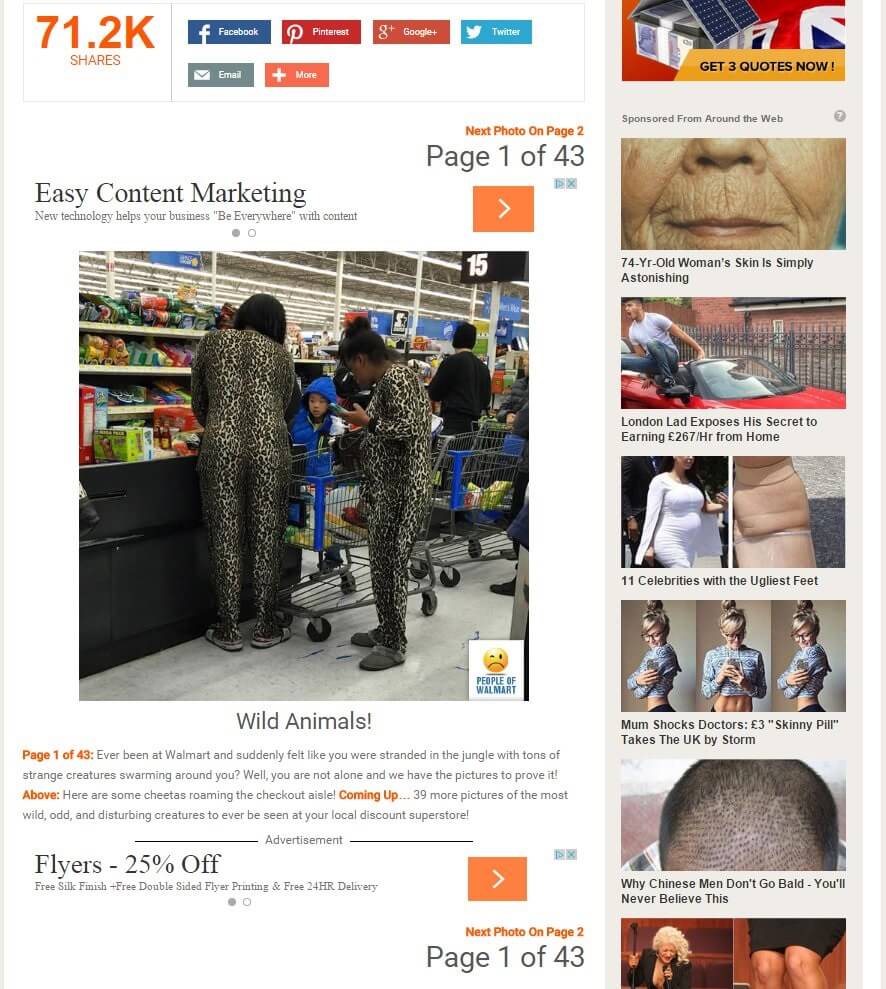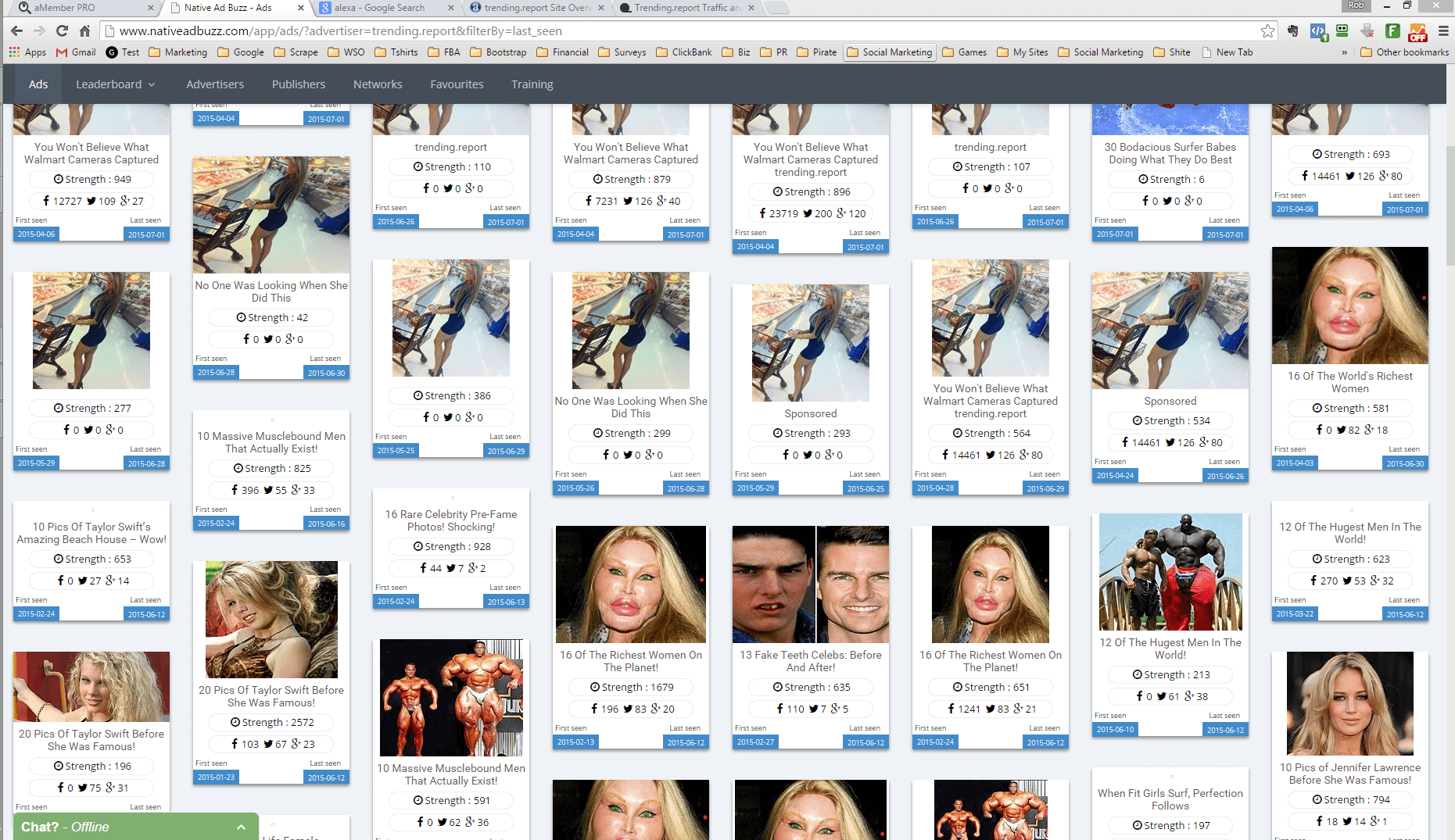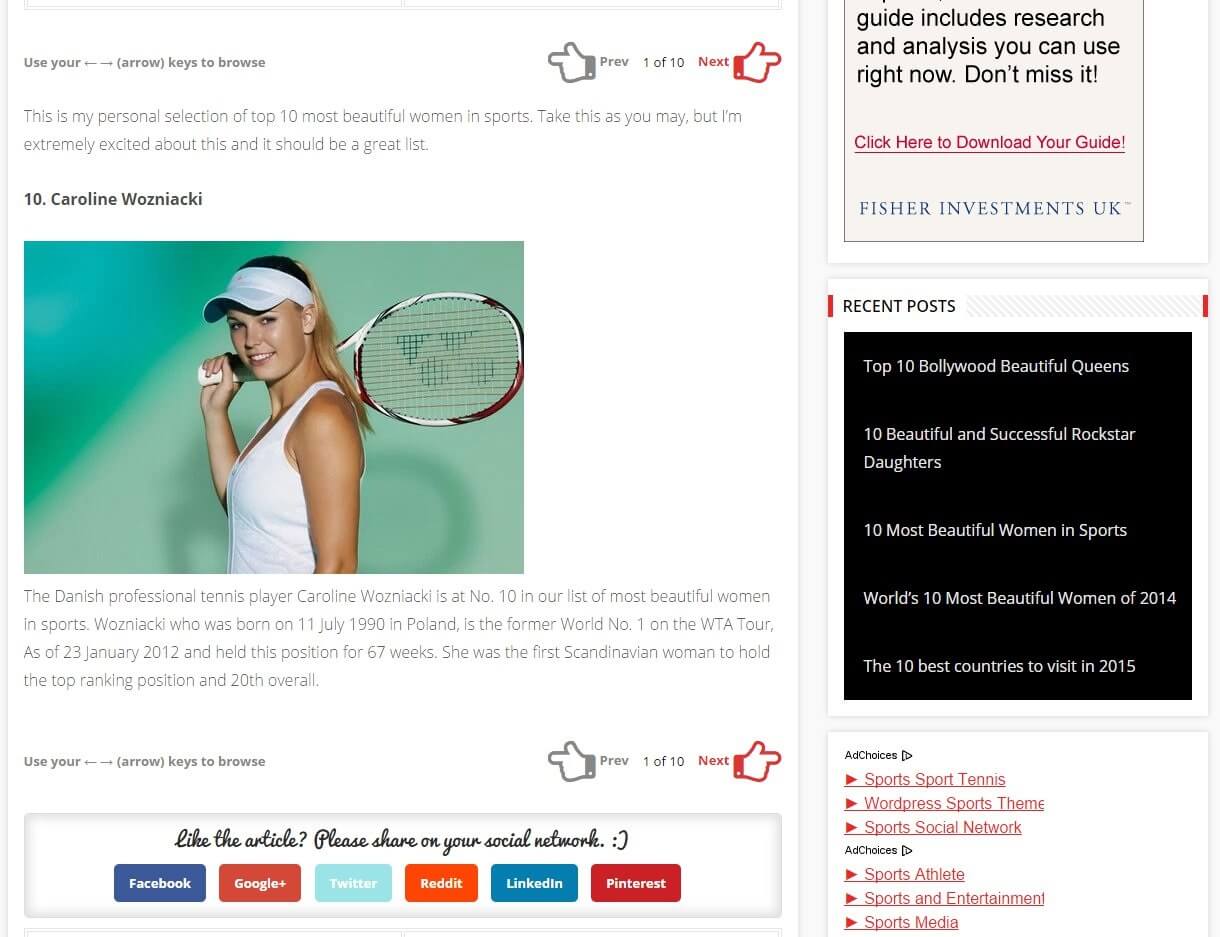So Native Advertising is the buzzword of the moment, but how can it make you money?
I’ve gone with the flavour of the day over the years; SEO, Adwords, FB, PPV, Adult, Mobile and from 2014 have focused exclusively on Native Advertising. I had seen the proliferation of trashy looking content thin, ad heavy sites all over the place, but it wasn’t until I met a chap  who had started one of these sites in November 2014 and was making $60k profit a month within 4 months that I really took notice.
who had started one of these sites in November 2014 and was making $60k profit a month within 4 months that I really took notice.
I personally couldn’t give a shit which celebrities look crap with no makeup, who has had a boob job, who has gone bankrupt, who’s having sex with whom and who looks better in a bikini at 40 than 20. OK I lied about the last one and I might click on it. I also might click on “15 Celebs Reveal Their Bodies In Outrageous Bikinis” (it’s been running for 5 months) but I would hate myself for it.
In-fact as I click next on each ad heavy, slow loading page waiting impatiently until I see the image I saw of what looked like a bikini top strai ning not to break on the ad I really do hate myself. Not because I’m wasting my time (it doesn’t count when I’m researching (same as when I was running adult campaigns)), but I hate it because I know the numbers.
ning not to break on the ad I really do hate myself. Not because I’m wasting my time (it doesn’t count when I’m researching (same as when I was running adult campaigns)), but I hate it because I know the numbers.
The ad I clicked on would have cost the publisher 5 to 20 cents for the click (proper breakdown of the numbers below).
He has 4 placements from Adsense, one from a company I had only just heard of and about 24 banner and text ads from two native advertising (content recommendation) networks. After clicking on his ad “16 Reasons Yoga Pants Are The Best Invention Ever” (which for the record I only clicked on because I am interested in inventions) I see one “research picture” per page and a brief sentence so I have to click next 16 times.
It was actually quite hard to find the “next” button and even though I know what I’m doing I first clicked on an Adsense ad with an arrow pointing to the right. Cha chinnnng and it ain’t my cash register that’s ringing. I am now responsible for 16 page views and (at least) 1 ad click on his site. He’s near enough doubled his money based on his cost of acquiring my visit, and pixelled me with 3 retargeting networks where he can razor target me in the future with dirt cheap ads about inventions 🙂
He has now made money out of me today and can target me with future “interesting and relevant” click worthy and share worthy viral content better than if I had signed up to his email list. If I didn’t know his numbers – damn his eyes – I may well have clicked like on his page and be responsible for sending him thousands of free clicks from Facebook (because my friends like inventions as well).
Not a bad business model he’s got.
DEFINITION of ‘Arbitrage’
The simultaneous purchase and sale of an asset in order to profit from a difference in the price. It is a trade that profits by exploiting price differences of identical or similar financial instruments, on different markets or in different forms. Arbitrage exists as a result of market inefficiencies; it provides a mechanism to ensure prices do not deviate substantially from fair value for long periods of time.
Source: investopedia.com
WTF? This is the tinterwebs not the stockmarket. Yes, but the same principle applies. In fact the same principle applies to the fruit and veg market stall holder, the stockbroker, the bookie, the wholesaler the… well anyone in business. Buy low and sell high. Durrr.
Arbitrage has been around on the internet since it was first monetized. It’s nothing new. It’s a game of cat and mouse between publishers, advertisers and ad networks. It changes over time, trends come and go. People’s accounts get banned, you know the score. Build a list and re-target so that if you do get banned in whatever you are doing even if it’s not your fault you always own an asset and can enjoy traffic and conversions again quickly.
OK I digress. Back to native arbitrage. It’s following a proven business model. Good. Native advertising is the fastest growing form of advertising at the moment and is predicted to be so for a few years. Good. It’s a relatively uncrowded scene. Good. It’s not that hard to do when you break it down. Really?
Yes. Basically what we as marketers have been doing for years when developing websites to gain traffic is write big long keyword heavy search engine friendly articles with plenty of pictures that are easy on the eye. That seemed to tick google’s boxes, so we got traffic via paid means and organically and then we set about monetizing those sites, some people to lots of success (w inners), others to not much or no success never to be heard from again (day jobs). There was an arbitrage formula for becoming a winner that day jobs just didn’t get. The winners would probably then sell their site on flippa and take their money into a new bigger venture based on what they had learned or just spin up several more cash cows outsourcing the majority of the process using what they had learned and their new riches.
inners), others to not much or no success never to be heard from again (day jobs). There was an arbitrage formula for becoming a winner that day jobs just didn’t get. The winners would probably then sell their site on flippa and take their money into a new bigger venture based on what they had learned or just spin up several more cash cows outsourcing the majority of the process using what they had learned and their new riches.
That’s all very well and when done the way that people like Ryan Deiss are preaching these days, it still works very well. Acquire visitors, follow a proven method to turn them into customers. Earn more money from the click than it cost you. Arbitrage.
So what’s so different about a native ads trashy arbitrage site? The main thing is that rather than big long content heavy pages, they are full of ads most of which are native. They are very light on content and what content their is is usually very eye catching images and a couple of sentences at most for each image.
There are a few links to other pages on the same site, but the emphasis is on showing lots of ads and having a next / previous button cunningly hidden in amongst those ads. So what would have traditionally been one post needs several page refreshes to consume. It’s not rocket science and is purely designed to increase the number of ad impressions and therefore earnings from a visit. From what I’ve seen people seem to be happy to use sites like these. I hate them, but this aint about me.
A Typical Native Ad Trashy Arbitrage Site
Here’s an example of what I mean about the strange nav.

Big tip: I have been involved in building a few of these sites now both from a consulting and owning point of view. The next / previous buttons are a key element to test. You may think it cheap and cheesy to hide / camouflage / disguise these as content, but it pays. Don’t tell me you don’t want to make money out of your arb site. If you want to write some sort of community save the world site, do it with the profits you make from your native ad arbitrage site.
Huuuge tip: Check out the big orange arrows kindly provided by google which are corralled in by “next photo on page 2” in the same colour and “Page 1 of 43”. Do you think someone might actually click on those? Shame on that website owner for increasing his ECPM. Choose your ad format wisely. Oh and also notice how they are appeasing the google shit hammer with ——— Advertisement ———-?
Here’s an example of what I think is a bad native arb site that could make a lot more money.
I hate giving this shit away without a retainer, but have a guess what would be the first thing I would do if I was asked by the owner to help him make some more money from this site…
So where does this leave you? Well the first thing you need to understand is why native ads exist in the first place. We have written about that elsewhere on this blog and you can find a ton about it on the web, but suffice to say people are bored of banners and it’s an easy way for advertisers to make their content blend in with the content of a traffic site. What you need to know is that BIG web properties like Forbes, CNN, NBC, MailOnline etc etc are using them.
Why is that?
Because they make more money than banners duuurrrr.
These sites are owned by savvy ruthless shareholders who want to sweat the maximum money from every asset and visitor, not make the visitor’s journey as pleasant as possible.
Soooooo. Native ad content recommendation networks pay website owners a decent pile of cash to show their ads. Websites are now squeezing multiple page impressions out of what used to be just one and the users are buying it. That’s clever isn’t it?
So how many spondoolies can you make out of this? Depending on the site, the traffic and location I have seen myself or heard other people say that Taboola can make $1.5 – $4.5 eCPM which fits in with other traffic sources. A fairly new source who I haven’t tested yet Ayboll are claiming $2.5 – $6 eCPM.
I won’t out our earnings or any of the customers I work with so the following is blatantly pinched from an article on the MonetisePros site at http://monetizepros.com/display-advertising/which-sponsored-content-network-is-best-taboola-outbrain/
If you’re trying to make money out of a website and not reading their stuff you should be.
How Much Can Publishers Make from Taboola and Outbrain?
According to a Financial Times interview with Outbrain’s managing director in Europe, the network shares “about half” of any revenue generated with partner sites. The cost per click paid is said to range from $0.15 to $0.30 while click rates are in the neighborhood of 0.50% to 0.75%.
Using those (big) ranges, we can come up with some revenue estimates:
$0.15 CPC x 0.50% CTR x 50% revenue share = $0.37 per thousand pageviews to publishers
$0.30 CPC x $0.75% CTR x 50% revenue share = $1.12 per thousand pageviews to publishers
In other words, most publishers will see RPMs between $0.37 and $1.12 with Outbrain. That translates into $370 to $1,120 per million pageviews, meaning that you’ll need to have a pretty substantial audience in order to generate meaningful revenue from these widgets.
Serves up 1.5 billion recommendations daily, or about 45 billion monthly [they do way more than this now]
Drives 24 million unique visits for advertisers
Recently crossed the $100 million revenue run rate
That would translate into revenue per click (unique visits sent) of about $0.35, which is roughly in line with Outbrain (perhaps a bit higher). It also implies a click rate of about 0.05% per recommendation, which translates into 0.20% to 0.30% per page (since the Taboola widget often includes multiple recommendations). That gets us to about $1.00 in gross RPM (i.e., $1.00 in total revenue generated per thousand pageviews) before taking into account Taboola’s cut.
It seems likely that Taboola is sending more monthly unique visitors than the 24 million estimated by Compete, since not all advertisers create a custom tracking URL or redirect traffic through Taboola.com. In that case, the click rate would be a bit higher and the average CPC a bit lower–meaning that the Taboola metrics are likely in the same ballpark as the more concrete figures available for Outbrain.
[It’s me again] This is a bit lower earnings than mentioned before, but it does have a few assumptions.
So how much can you earn with this? Here’s a couple of shots of a domain we’ve been tracking for a few months.
Infact as you can see they’ve only been going a few months and they’re had steady growth up to 10.2 million UNIQUE VISITORS a month. Let’s assume each of those visitors looks at 10 pages in a month then that is 10,000,000 page impressions. A month. Go work out the income based on the eCPM’s above 🙂 and as you can see from my next screenshot they are not even working it it that hard (in terms of the ads and angles they are testing).
Oh and if you want to see all the ads they’ve tried, the winners and the losers, the ones that got the most free shares (hint – these are good ones to copy), here’s a complete overview of all the ads they’ve run in Native Ad Buzz

Surprisingly they’ve not actually tried that many angles.
So how hard is it to put this into place?
Look if you’ve found us in the sort of places we advertise or people are talking about us and have read this far you probably know more than a bit about internet marketing.
You can throw a wordpress site together, make a couple of phone calls to a traffic network, rustle up some cash to buy ads (yes it’s a business, build it and they won’t come unless you invite them to), and plan out some congruent ads with some eye catching landers. Good you have all the skills necessary. So where do you start?
Erm I just showed you. Let me break the process down for you…
What we are doing at Native Ad Buzz is nothing new. We have just taken a proven business model, applied our angle to it, focused it on what is working right now and priced it at a level that anyone can use to get an edge.
Internet advertising intelligence has been around for years and is simply based on what press, then media clipping agencies have been doing for years with newspapers, magazines, radio, tv and the internet. One hundred and sixty three years to be precise.
The first press clipping agency was started in London in 1852 by a Polish newsagent called Romeike. Actors, artists, writers and musicians used to visit his shop to pore through the European newspapers looking for news about themselves and their competitors. Romeike spotted an opportunity and turned it into a business.
This model was further enhanced in 1879 by a Parisian called Alfred Cherie who offered a press clipping service to actors enabling them to only buy the articles about themselves rather than the whole newspaper.
Enter Tony Robbins …
If you want to be successful, find someone who has achieved the results you want and copy what they do and you’ll achieve the same results.
Whoa Rob so where the fuck does this fit in with me? I’m just trying to start a new project on the internet and make some money. I’ve heard native is the thing right now, arbitrage makes sense, I’m willing to work hard, put some money, time and sweat in, but am not sure exactly what to do.
Well hold your horses. All the people I’ve talked about in this article need a bit of competitive intelligence to get them going. The veggie market stall holder might send a secret shopper to his competitor’s stall and talk to his wholesale suppliers about what people want and where he can buy it cheap.
If you were planning to start a restaurant in your town you would probably sample quite a few and focus on the ones that were good and copy one of them. If you just did your own thing based on what you like, the decor you like, the menu you like, the location the price the… everything… how likely would you be to succeed. If on the other hand you subscribed to trade publications, monitored the local press and web for reviews, talked to people, heard what people were recommending, saw where the queues were the longest and copied what one of these places did would you be more likely to succeed?
So for your new native arbitrage site, find some sites that are successful, copy what they do and put your own spin on it.
TRACK EVERYTHING – know your numbers.
Work out what’s working. Do more of what’s working and less of what’s not. Try out new stuff you see is working.
It just so happens we have a great way of helping you do that and it’s been working well for 163 years. Cut out the shit. Focus solely on what you need to know. Copy what is working well for others. Pay only for what you need and what is working right now.
Where do you get content? You could go the long way; BuzzFeed, the internet, FB etc or you could make it easy on yourself and just look in Native Ad Buzz. Find what trashy articles have gone viral for other people.
I don’t recommend copying people’s images, but if you do then make sure you cite the source whether that’s Pinterest, another site or wherever and you should be OK. Caveat I am not a legal bod so don’t take this as gospel. I usually work on the premise that by the time you get big enough to be found out copying people’s stuff and they threaten to get legal on you then you will be making enough money to pay a horde of freelancers to replace everything with legit images overnight.
Hopefully this article has given you an overview of a currently trending business model with a low barrier of entry and sky high potential. So to summarise and give the 3 points mentioned in the title.
- Use Native Ad Buzz to find out what’s working and why
- Use what you find as a guide for what you should be doing, copy sites and angles you see and add your own spin to them
- Test like a mad scientist. Test everything. Do more of what’s working and less of what’s not.
Here’s an example of how to do this:

